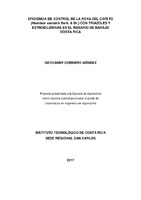Eficiencia de control de la roya del cafeto (Hemileia vastatrix Berk. & Br.) con triazoles y estrobilurinas en El Rosario de Naranjo Costa Rica
Abstract
A study was carried out in the town of Rosario de Naranjo, in the province of Alajuela, Costa Rica, in order to evaluate the use of the mixtures of triazoles with strobilurins for the control of the Roya del Cafeto (Hemileia vastatrix Berk. & Br.). In August 2016, an absolute control treatment with no application was established and a single application with three treatments corresponding to commercial fungicidal products (PC), PC A (trifloxystrobin+cyproconazole at 600 ml/ha), PC B (pyraclostrobin+Epoxiconazole at 800 ml/ha) and a mixture of PC C (triadimenol at 500 ml/ha) + PC D (trifloxystrobin+tebuconazole at 100 g/ha). Eight evaluations were performed with a 15-day interval measuring the percentage of Roya incidence and the time at which the treatments were kept below the threshold of 15% of disease incidence, where PC B showed a biological efficacy of 75 days before exceeding the threshold, while PC A exceeded this threshold at 60 days and in the case of PC C +PC D the duration was 45 days. Regarding the costs per application, the cheapest treatment was PC C + PC D with 26.026 colones/ha, while treatments corresponding to PC A and PC B presented costs per application of 31.676 and 34.476 colones/ha respectively.
vi
However, when taking into account the number of days of effectiveness and the daily cost per treatment, the treatment of PC B is the most efficient with a cost of 459,68 colones/ha/day, while the cost in the PC B was 527,93 colones/ha/day and the PC C +PC D mixture was 578,36 colones/ha/day. In terms of production, the treatment of PC C +PC D was the one that obtained the highest weight with 3,54 kg/plant, being this one 12,4% higher than the weight of the treatment with PC B (3,15 kg/plant), 30,4% higher than PC A treatment (2,94 kg/plant) and 71% compared to the control treatment without application (2,07 kg/plant).
Description
Proyecto (Licenciatura en Ingeniería en Agronomía). Instituto Tecnológico de Costa Rica, Escuela de Agronomía, 2017.


